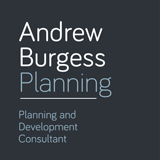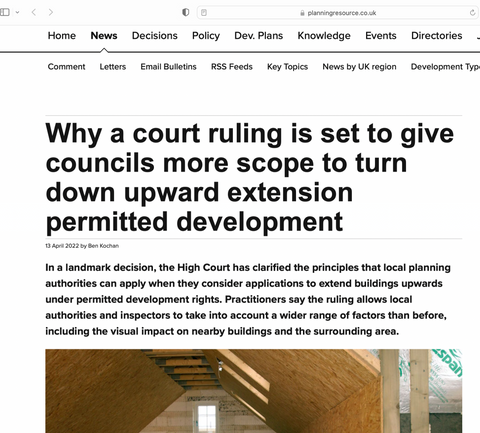Why a court ruling is set to give councils more scope to turn down upward extension permitted development
13 April 2022 by Ben Kochan
In a landmark decision, the High Court has clarified the principles that local planning authorities can apply when they consider applications to extend buildings upwards under permitted development rights. Practitioners say the ruling allows local authorities and inspectors to take into account a wider range of factors than before, including the visual impact on nearby buildings and the surrounding area.
A series of new permitted development (PD) rights allowing upwards extensions on a range of residential and commercial buildings without the need for a planning application came into force in August 2020. The six rights permit extensions of up to two storeys to create new homes or to allow existing homes to expand.
Recent research by Planning has found that the rights, which are subject to a number of considerations under a prior approval process, have a high refusal rate by local authorities. Now, a landmark judgment by the High Court may give councils greater scope to reject such applications, experts suggest. The ruling clarifies the principles that local planning authorities can apply when consider them, allowing them to take into account a wider range of factors, including the visual impact on surrounding buildings and their amenities and the street as a whole.
The judgment by Mr Justice Holgate focused on three cases where planning inspectors had dismissed appeals against local authority refusals of prior approval. The developers behind the schemes argued that the inspectors in their cases took too broad an interpretation of Class AA of Part 1 of Schedule 2 of the 2015 General Permitted Development Order (the GPDO).
Class AA permits a single house to expand by adding up to two storeys, or just one storey if its a single-storey building. The GPDO states that, before granting prior approval, councils must consider the impact of proposals on the amenity of “adjoining premises”, including overlooking, privacy, loss of light and the external appearance of the extended house.
The judge however ruled that “adjoining premises includes neighbouring premises and is not limited to premises contiguous with [next to] the subject property”. Holgate also found that “the control of the external appearance of the dwelling house is not limited to impact on the subject property itself, but also includes impact on neighbouring premises and the locality”.
Holgate’s judgment states that, in addition to class AA, five other similar PD rights were introduced at the same time that allowing upward extensions on different kinds of premises (see panel below) and that his judgement was relevant for them too.
According to Charles Streeten, the planning barrister from Francis Taylor Building Chambers who represented the developers, they have sought permission to appeal and are awaiting a decision from the Court of Appeal about whether this has been granted. However, commentators say the judgment is already having an effect on how councils consider prior approval applications.
“I’ve had discussions with one local authority about a scheme and the judgment and the issues it raises immediately came up,” said Andrew Burgess, principal at consultancy Andrew Burgess Planning . “Councils now have confidence that they can take a wider look at applications.”
“The prior approval process for upward extensions was introduced by the government to provide a route for developers to boost housing supply,” said Rob Sellen, a planning consultant at lawyers Paris Smith. “But it has proved unpredictable with almost half of applications being turned down by local authorities. Around 80 cases have gone to appeal and 60 per cent of them have been successful.”
“Holgate’s judgement could help clarify the process local authorities need to undertake to assess applications for prior approval,” said Peter Geraghty, development management spokesperson for local authority body the Planning Officers Society. “It could provide some transparency and consistency in the way applications under the PDR for upward extensions are handled.”
“Council planning officers can now make a judgement on the quality of a scheme before agreeing that it qualifies for prior approval,” he went on to say. “They can be confident that their decision is unlikely to get turned down on appeal if they do look at the wider impact.”
“Communities have found it hard to understand how the decisions are made to allow upward extensions with so little scrutiny,” suggested Michael Bach, planning chair at the London Forum of Civic and Amenity Societies. “In outer London, prior approval decisions have meant some extensions have been built which are completely out of character with an area. Hopefully, they will not be allowed any more.”
“Up to now, councils and planning inspectors have taken widely divergent views,” said Mark Morris, a planning consultant at design and planning consultancy Urbanist Architecture. “Some local authorities, like Camden in north London, have interpreted the guidance literally and taken the view that they have very limited grounds to turn down the applications, whilst other councils have looked more far more broadly at their impact.”
According to Hashi Mohamed, a planning barrister at No5 Chambers, appeal decisions on this issue have also been conflicting. “Most inspectors have taken more limited perspectives on the issues that can be taken into account when assessing applications for prior approval,” he said. “It is now clear that they can consider issues beyond the application site when upward extension schemes are referred to them on appeal. The court emphasised that the properties do not sit in a vacuum but have a relationship with their surroundings.”
“The wording in the GPDO is unclear about how councils should consider upward extensions,” suggested Rob Kryszowski, assistant planning director at Haringey Council, where two of the schemes subject to the High Court challenge are located. “It would be good if government gave some guidance on how these prior approval applications should be assessed. The guidance shouldn’t be too specific, but should allow council planners to use their judgement.”
Adam Donovan, planning director at consultancy Lichfields, said the judgement is likely to mean that developers “will have to work far harder on their schemes to get an approval by providing more design detail and impact assessment”. It “could lead to even more refusals unless the applicants present more detailed analysis of their schemes”, he added.
Burgess suggested that “at the very least, applicants will need to produce a daylight report”. “They will need to demonstrate in detail how an upward extension would affect access to light in adjoining properties,” he said. According to Burgess, this PD right “has attracted a lot of interest among smaller housebuilders and they could now be deterred from taking on such schemes”.
Henry Butler, a planner at consultancy Savills, suggested that housebuilders should consider setting back the additional storeys when they design the upward extensions on existing homes. “This would reduce the impact on the streetscape,” he said.
Ian Ginbey, a planning partner at law firm Clyde & Co, suggested that rather than using PDR to get approval for an upward extension, developers may instead choose to make a planning application. “The requirements now for a successful PDR application are likely not to be much less onerous than for a standard planning application,” he pointed out.
The upward extension permitted development rights
The first right, published in late June 2020 and taking effect from August 1 that year, was introduced via the Town and Country Planning (Permitted Development and Miscellaneous Amendments) (England) (Coronavirus) Regulations 2020, which amends the Town and Country Planning (General Permitted Development) (England) Order 2015. It is designed to allow up to two additional storeys to be constructed on existing stand-alone purpose-built blocks of flats to create new homes. It requires prior approval on a range of criteria including its appearance, impact on air traffic, and the provision of natural light. The right does not apply to blocks built before July 1948 or those in conservation areas, national parks or areas of outstanding natural beauty. In an impact assessment, the government’s impact assessment estimates “that this measure could deliver up to 800 extra housing units per year”.
The second set of five further rights, published in late July 2020 and which came into force from 31 August that year, were also introduced via changes to the GPDO. One right allows two additional storeys to be constructed to extend existing homes. In addition, the regulation created four new rights allowing the construction of two additional storeys on detached, semi-detached and terraced homes and commercial and mixed use properties, to create new self-contained flats. These rights also require prior approval on a similar range of matters to the first one. The government’s impact assessment estimates that this measure “could deliver around 7,800 extra housing units per year”.


